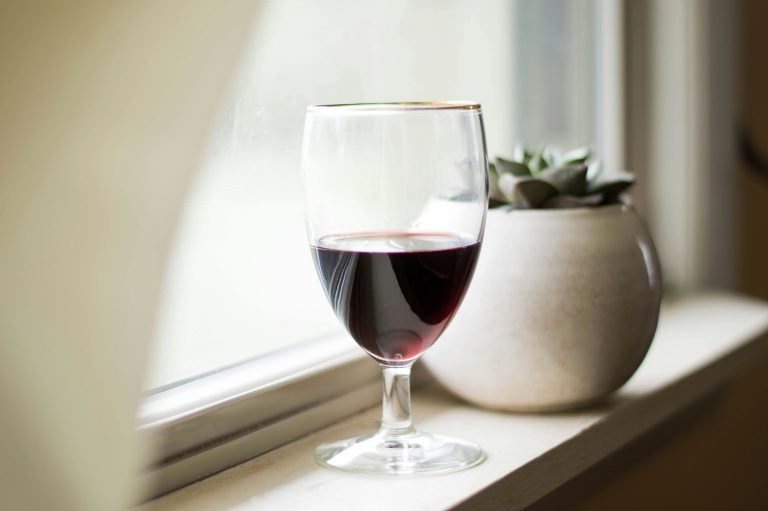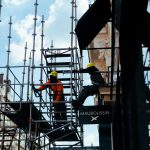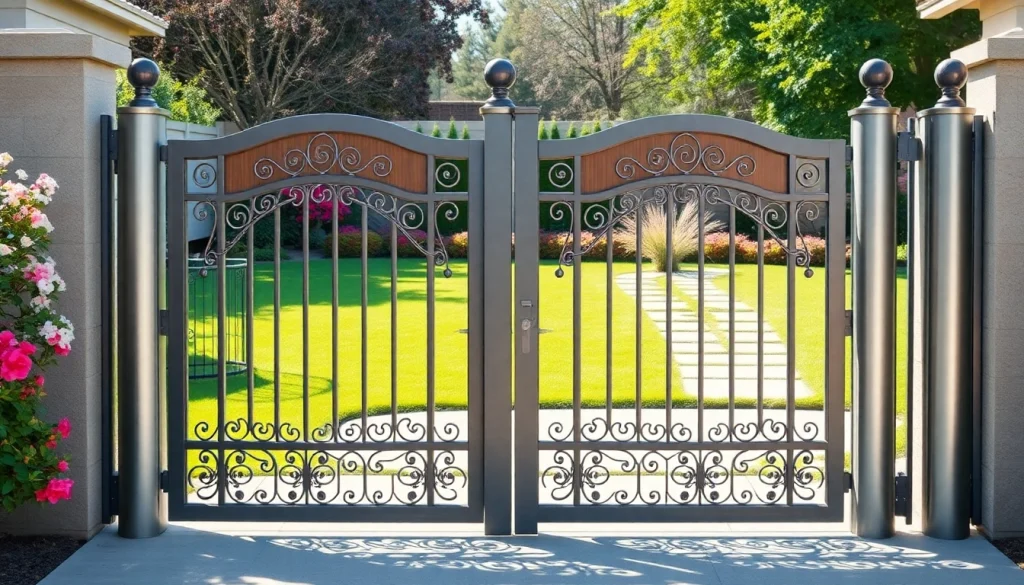Understanding Custom Steel Gates
What Are Custom Steel Gates?
Custom steel gates are tailored entrances made from steel, designed to meet specific measurements, aesthetic preferences, and functional requirements. Unlike mass-produced gates, these gates offer a unique solution that enhances the appearance and security of residential and commercial properties alike. Available in various designs, finishes, and styles, custom steel gates can be integrated into various architectural environments, combining both beauty and brawn.
Benefits of Custom Steel Gates
Investing in custom steel gates comes with numerous advantages that extend beyond mere aesthetic appeal.
- Durability: Made from high-quality materials, custom steel gates are built to withstand harsh weather conditions, ensuring longevity and minimal maintenance.
- Security: Steel provides a robust defense against intrusions. Custom designs can include additional security features, such as lock systems and reinforced structures.
- Aesthetic Appeal: They enhance the property’s curb appeal, allowing owners to express their unique style while also increasing property value.
- Versatility: Available in countless styles, custom steel gates can be shaped to fit any architectural design or personal preference.
- Personalization: Homeowners can choose finishes, colors, and additional design features, ensuring the gate complements their property perfectly.
Types of Custom Steel Gates
Custom steel gates can be categorized into several types, each serving different needs and purposes:
- Swing Gates: These are the most traditional type, swinging open on hinges. They can be made as single or double gates depending on the width.
- Sliding Gates: Perfect for properties with limited space, sliding gates open by sliding along a track rather than swinging outward.
- Bi-Folding Gates: These fold in on themselves, making them an excellent choice for properties needing to maximize available space.
- Pedestrian Gates: Custom steel pedestrian gates offer access for foot traffic while coordinating with larger vehicle gates, ideal for residential properties.
- Decorative Gates: Often featuring intricate designs, these gates serve primarily as decorative elements while still providing a barrier.
Choosing the Right Design
Factors to Consider in Design
When selecting the design for a custom steel gate, several factors should be evaluated to ensure the final product meets both functional and aesthetic needs:
- Functionality: Consider how the gate will be used. Will it act solely as a barrier, or will it also need to facilitate foot and vehicular traffic?
- Size: Accurate measurements of the entryway are crucial. Gates that are too small or too large can create accessibility issues.
- Style: The design should reflect your personal taste and complement the property’s architectural style.
- Materials: Think about the type of steel and finish to be used. Galvanized steel is often recommended for its corrosion resistance.
- Local Climate: Consider the weather conditions in your area. Some finishes may not hold up against extreme temperatures or moisture.
Complementing Your Home’s Architecture
Your custom steel gate should enhance and complement the existing architecture of your home. Here are some tips to ensure harmonious integration:
- Color Coordination: Choose a finish that matches or beautifully contrasts with the exterior of your home.
- Design Elements: Incorporate design elements found in your home, such as motifs, textures, or even colors, to create a cohesive aesthetic.
- Scale and Proportion: The gate must be appropriately sized and proportionate to the entrance and the surrounding architecture to avoid looking out of place.
- Landscaping: Consider the landscaping surrounding the gate. Aligning the gate’s design with your garden and other architectural features will create a unified look.
Popular Styles of Custom Steel Gates
There are myriad styles available, each with its distinctive charm. Notable designs include:
- Modern Minimalist: Characterized by clean lines and simplistic designs, modern gates often incorporate geometric shapes and open frameworks.
- Traditional Ornate: Featuring intricate patterns and decorations, these gates often evoke classic elegance and sophistication.
- Industrial: With a focus on raw materials and utilitarian designs, industrial gates often showcase the natural texture of the steel.
- Rustic: Utilizing aged or weathered finishes, rustic gates can create a charming and inviting aesthetic, perfect for country homes.
- Contemporary: This style blends modern elements with innovative designs, often focusing on unique orientations and high-quality finishes.
Installation Process of Custom Steel Gates
Preparing Your Space for Installation
Before installing a custom steel gate, proper preparation of the site is crucial for a seamless process:
- Clear the Area: Remove any obstructions from the installation area, including plants, debris, and old fencing.
- Check Local Regulations: Ensure compliance with local building codes and regulations regarding gate construction and installation.
- Site Assessment: Evaluate the ground where the gate will be installed. Leveling may be necessary to ensure smooth operation.
- Gather Tools and Materials: Prepare all necessary tools, including drills, level, concrete mix, and anchors, beforehand to avoid interruptions during installation.
Step-by-Step Installation Guide
Installing a custom steel gate involves several steps, as outlined below:
- Measure and Mark: Measure the openings accurately, and mark where the gate will be installed using markers or spray paint.
- Prepare the Posts: Dig holes for the posts where the gate will be fixed. Ensure they are deep enough for stability.
- Set the Posts: Place the posts in the dug holes, ensuring they are straight and level. Fill with concrete mix to secure them in place.
- Attach Hinges: Once the posts are set, attach the hinges to the gate and fix them to the posts, ensuring the gate swings correctly.
- Add the Locking Mechanism: Install any locking systems or latches per your chosen design.
- Final Adjustments: Check for proper alignment and make necessary adjustments to the hinges or gate placement.
- Test the Gate: Before finishing, test the gate’s operation to ensure it opens and closes smoothly.
- Complete the Area: Once installed, clean the area around the gate, securing any landscaping as needed.
Common Challenges and Solutions
While installing custom steel gates can be straightforward, some challenges may arise:
- Misalignment: If the gate does not align correctly, double-check the hinge placements and make necessary adjustments.
- Gate Weight: Steel gates can be heavy; ensure that the posts are sturdy enough to support the weight and prevent sagging.
- Weather Factors: Working in adverse weather conditions can complicate installation. Plan for a dry day to avoid issues with concrete setting.
- Inadequate Measurement: Always double-check measurements to avoid ordering a gate that does not fit. If in doubt, consult a professional for advice.
Maintenance Tips for Longevity
Caring for Custom Steel Gates
To ensure your custom steel gate remains in optimal condition, regular maintenance is necessary. Focus on the following care practices:
- Regular Cleaning: Utilize a mild detergent and water to clean the gate periodically, removing dirt, grime, and any corrosive substances that may accumulate.
- Inspect for Damage: Regularly check for any signs of rust, dents, or other issues and remedy them immediately to prevent further damage.
- Lubrication: Apply lubricant to hinges and moving parts at least twice a year to ensure smooth operation.
- Paint Touch-Ups: Address any scratches or chips in the finish promptly to prevent rusting. Keep a matching paint for easy touch-ups.
Preventative Measures Against Damage
Preventative care can extend the lifespan of your custom steel gate:
- Use Rust-Resistant Coatings: Opt for gates that have been galvanised or powder-coated for enhanced durability against rust.
- Install Weather Stripping: This can prevent moisture build-up, reducing the risk of rust and corrosion at the fence base.
- Avoid Contact with Moisture: Ensure that no vegetation grows too close to the gate, as it can trap moisture and encourage corrosion.
Seasonal Maintenance Checklist
To effectively maintain your gate throughout the year, consider the following seasonal checklist:
- Spring: Conduct a thorough cleaning, check for rust, and lubricate moving parts.
- Summer: Inspect for signs of warping due to heat. Reapply protective coatings if necessary.
- Fall: Clear debris and fallen leaves, ensuring no dampness or moisture traps occur.
- Winter: Inspect for ice buildup and ensure the gate operates freely without obstruction.
Maximizing Security with Custom Steel Gates
Security Features to Consider
When opting for custom steel gates, security should be a top priority. Consider implementing the following features:
- Locking Mechanisms: High-quality locks, including smart locking options, can dramatically increase security.
- Reinforced Structures: Gates should be designed to resist forced entry and be difficult to breach.
- Security Cameras: Integrating security systems or cameras can provide surveillance of the gate area, enhancing overall security.
Integration with Home Security Systems
To further enhance security, integrating the custom steel gate with a home security system ensures a comprehensive protective measure:
- Remote Access: Allow homeowners to control gate access remotely through smart home applications.
- Alarm Features: Consider installing an alarm system that triggers when tampering is detected.
- Intercom Systems: For added security, install an intercom to monitor and manage access to the property.
Assessing Durability and Strength
When selecting custom steel gates for security purposes, assessing durability and strength is paramount:
- Gauge Thickness: A higher gauge number indicates thinner steel. Opt for lower gauge steel for sturdiness.
- Welding Quality: Inspect the welds for quality craftsmanship, as strong welds play a significant role in the overall strength.
- Design Strength: Consider designs that optimize strength, such as those incorporating cross beams or panels that distribute weight evenly.





